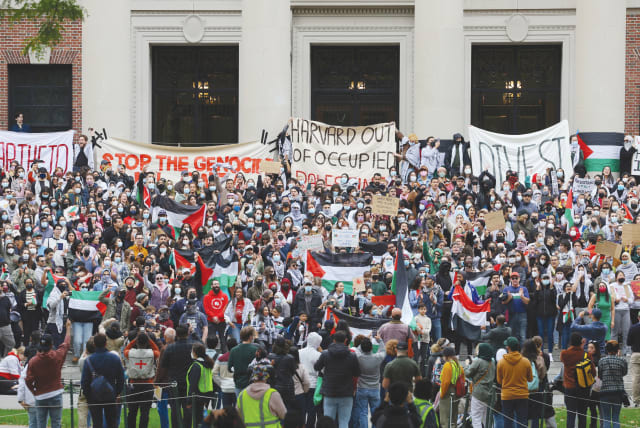Hanukkah’s Eternal Flame: Confronting Ideological Conflicts in Liberal Thought

We must show the world how Israel's current battle against Islamic fundamentalism continues an ancient struggle.
As a Harvard-educated Orthodox Jew, whose family history bears the scars of the Holocaust, I find myself at a historical and ideological intersection. This intersection reveals a troubling truth: the ideology of Hamas has alarmingly resonated with students and liberals globally, as well as within Harvard's walls.
Harvard's embrace of moral relativism, betraying its motto 'Veritas' (Truth), exemplifies a concerning trend. Such relativism blurs the line between right and wrong, between good and evil, and ignores the objective truth. This is a dangerous deviation from the lessons learned from the horrors of unchecked antisemitism that led to the Nazis’ murder of 6 million Jews. This perversion of absolute moral values can be contrasted with the story of Hanukkah, which presents a starkly different paradigm of moral and ideological clarity.
Hanukkah is typically associated with the Maccabees' use of guerilla warfare to achieve military triumph over the more powerful Greeks. Yet the true essence of Hanukkah lies deeper than guerrilla warfare. The festival's heart is the menorah, symbolizing religious and ideological freedom. Contrary to popular belief, the Maccabees were primarily motivated by a need to resist religious persecution. Theirs was for the right to uphold beliefs and practices different from the dominant Hellenistic culture. This reframing shifts the focus from a physical battle to a profound struggle for ideological freedom, underscoring the menorah's significance as not just a reminder of a miraculous event, but as a beacon of enduring religious liberty and ideological tolerance.
In contemporary discourse, the Israel-Palestinian conflict is frequently oversimplified as just a territorial and power struggle, casting Israel as the stronger party and Hamas, the Islamist militant group governing Gaza, as the weaker. This reductionist view tends to frame the conflict in binary terms: oppressor versus victim, dominant versus subjugated, colonizer against colony. Such characterizations overlook the complex historical, ideological, and religious dimensions that define this enduring conflict, reducing it to a mere contest of power and territory.
Central to this misunderstanding is the role of Hamas, an organization deeply ingrained in Islamic fundamentalism. Hamas perceives the existence of a Jewish state in the land of Israel, as well as the presence of any non-Muslim groups, including Christians and atheists, as intolerable and fundamentally contrary to its religious and ideological tenets. This perspective shifts the nature of the conflict from a simple land dispute to a complex ideological and religious confrontation. It's essential to recognize this broader context to fully grasp the multifaceted dynamics of the conflict.
Hamas, an offshoot of the Muslim Brotherhood, seeks to reinstate a form of governance akin to historical caliphates, characterized by a strict interpretation of Sharia law. This vision includes the implementation of severe laws that persecute diverse groups, including LGBTQ individuals, Christians, atheists, and other non-believers, enforcing a homogenous religious and ideological doctrine. Such practices, including the reported persecution of homosexuals in Gaza, highlight the repressive nature of Hamas’s governance.
This imperialistic ambition of Hamas presents a profound threat, not only to the Jewish people, but also to the broader Middle East and Western societies. It challenges the existence of Israel as a Jewish state and the presence of any non-Muslim entities and secular Muslim entities in the region, viewing them as ideological aberrations.
Today, Israel's struggle echoes that of the ancient Maccabees. It's not merely a fight for territorial sovereignty but a deeper battle for democratic, religious, and cultural identity against an ideology that seeks total eradication. The Hanukkah story, with its emphasis on the triumph over religious and ideological oppression and intolerance, resonates profoundly in this context.
As the Hanukkah candles cast their light, they reveal that the Israel-Palestinian conflict is fundamentally a clash of religious beliefs and ideologies. It's a struggle for the survival of diverse cultures and faiths in the region, extending beyond Israel to encompass other minority groups facing similar threats.
The West's misunderstanding of this conflict puts it at risk of aligning self-destructively with ideologies that oppose foundational Western values like individual rights, religious tolerance, and democratic principles. A deeper comprehension of these ideological currents is essential.
As I light the Hanukkah candles, commemorating God’s miracles that enabled Israel to triumph over the Greeks' monolithic, intolerant views, I pray that the light of Hanukkah serves as a beacon today. May it reveal to the world that Israel's current struggle against the monolithic, non-tolerant values of Islamic fundamentalism is a continuation of that ancient battle.
Itamar Frankenthal, a Silicon Valley entrepreneur and investor, focused in advancing battery technology, is deeply committed to supporting the Jewish community. Frankenthal is also an executive member of a Jewish day school, while he champions moral clarity on social media, contributing significantly to both technological and societal progress.
This op-ed is published in partnership with a coalition of organizations that fight antisemitism across the world. Read the previous article by Adam Milstein.
Jerusalem Post Store
`; document.getElementById("linkPremium").innerHTML = cont; var divWithLink = document.getElementById("premium-link"); if (divWithLink !== null && divWithLink !== 'undefined') { divWithLink.style.border = "solid 1px #cb0f3e"; divWithLink.style.textAlign = "center"; divWithLink.style.marginBottom = "15px"; divWithLink.style.marginTop = "15px"; divWithLink.style.width = "100%"; divWithLink.style.backgroundColor = "#122952"; divWithLink.style.color = "#ffffff"; divWithLink.style.lineHeight = "1.5"; } } (function (v, i) { });
